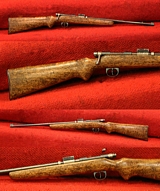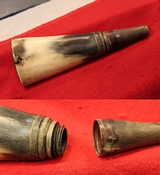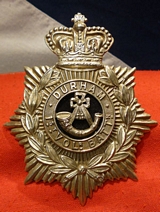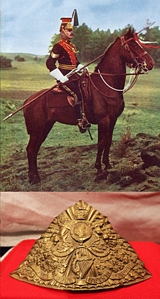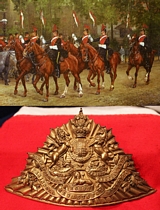Antique Arms & Militaria
An Early Fine Miniature Single Shot Bolt Action Rifle
Showing all the minute detail of the original bolt action rifle. European armies continued to develop bolt-action rifles through the latter half of the nineteenth century, first adopting tubular magazines as on the Kropatschek rifle and the Lebel rifle, a magazine system pioneered by the Winchester rifle of 1866. The first bolt-action repeating rifle was the Vetterli rifle of 1867 and the first bolt-action repeating rifle to use centerfire cartridges was the weapon designed by the Viennese gunsmith Ferdinand Fruwirth in 1871. Ultimately, the military turned to bolt-action rifles using a box magazine; the first of its kind was the M1885 Remington Lee, but the first to be generally adopted was the British 1888 Lee-Metford. World War I marked the height of the bolt-action rifle's use, with all of the nations in that war fielding troops armed with various bolt-action designs. Probably a Colt or Remington pattern. 6 inches long Non working original hand engineered miniature, made post war by renown miniaturist engineer Ronald Platt. read more
275.00 GBP
A Georgian 18th century Carved Horn Primer or Pistol Flask
made in the 18th and used into the early 19th century. With powder measure screw on cap. Cow horn with wooden base plate.
Firearms became more and more sophisticated during the 16th-century but still required a number of accessories to load and operate them. The main charge, placed in the barrel with the shot, was carried in the powder flask. Smaller priming flasks contained fine-grain powder for priming the pans of wheel-lock firearms. Flasks were attached to a bandolier, a type of sling worn over the shoulder or around the waist, from which hung the various accessories required for a weapon including spanners for the mechanism, measured charges, powder flasks and priming flasks. read more
220.00 GBP
A Victorian Durham Light Infantry Helmet Plate Ist Volunteer Battalion
In white metal with black centre. The 1st Durham Rifle Volunteer Corps was formed at Stockton-on-Tees in 1860, and in 1880 was amalgamated with other Durham corps, from Darlington, Castle Eden and Middlesbrough, to form a battalion of eight companies.
The 1st Durhams later became the 1st Volunteer Battalion of the Durham Light Infantry and as such gained the battle honour `South Africa 1900-02' for the services of its members during the Boer War. read more
175.00 GBP
Many Wonderous Pieces Added Every Day. There is Probably Nowhere Else In The World You Can View Such Fabulous & Historical Wonders,.. & Where Everything Is For Sale
All under one roof, intriguing and collectable artefacts, and specialist 1st edition rare books, plus militaria such as, an original, huge, and very rare 88mm WW2 Shell from a German 'King Tiger' tank, ranging to an original Imperial Roman Legionary’s gladius sword, a museum quality samurai sword by one of the great sword makers of early 14th century Japan. Or, a most rare, and absolutely stunning museum grade Christian samurai’s sword from circa 1630.
These past few weeks we have added, and are still adding, original, ancient artefacts, from Rome, France, Carthage, Persia, Greece, and Britain, many from fine English collections, originally acquired in the early 19th century, and then re-acquired from the descendants of those original collectors, in the 1990’s or even before by other collectors who subsequently sold them to us.
We have thousands of pieces, that you can can view [and buy] from our website. View and buy such treasures as a 2000 year old roman soldier's gladius sword, from the time of Julius Caesar, Augustus and Nero. A museum grade 1000+ year old sword of a Viking chieftain, king or earl [in Viking times called a jarl] that is inlaid with traces of knotwork silver inlay. A bronze and iron Archemeanid sword from the time of the Greco-Persian wars of Xerxes the Great against the Spartans at Thermopylae, or a Circa 2,500 Scythian infantry warrior’s bronze helmet. Plus, Imperial Roman 1st and 2nd century rings, the type such as worn by a Roman freed gladiator, or, the owner of slave gladiators, the Imperial Pretorian Guard, legionary officer's or nobles, often with the traditional symbols and figures, from the time of the Emperors Augustus, Tiberius, Caligula, Claudius and Nero. A superb 3rd to 4th century BC Falcata sword similar to the Greek Kopis, the sword used by Hannibal’s army in the 2nd Punic War and his invasion of Rome across the Alps, and a 3rd Century Imperial Roman Sword, from the time of Emperor Constantine and the Battle of Cibalae. Plus a remarkable 900 to 1066 period Original Viking- Norman Iron Four Plate Helmet, as seen depicted in the world famous so-called Bayeux Tapestry, plus, early and rare books, such as, an original very early printing of a 5th century Roman treatise on Roman warfare, and an 18th Century biography on 18th century Warfare, or a very rare 15th century incunabula by Bartolomeus Platina personally commissioned by Pope Sixtus IV.
Plus, as usual, many, many thousands of pieces of historical interest, from one of the oldest and still thriving [if not the oldest surviving] traditional, purveyors of original ancient, antique and vintage historical militaria, companies in Europe, family based through generations in the city of Brighton, and for over 100 combined years located in the Brighton Lanes.
Our family partners Mark and David have dedicated between them, a combined 90 plus years together, serving the world's collectors. Some are the simplest of collectors, some with most eclectic tastes, covering all fields of interest spanning millennia, others, highly specific, if not profound. Very recently we found for a specialist book collector a most rare ‘Subscriber’s Edition’ 1926 Seven Pillars of Wisdom, by T.E. Lawrence, a book that the collector had been searching for for 20 years, and we had joined in that search for him around 10 years ago. He had seen two volumes of that edition around 10 years ago, but discounted both of them, as not quite the perfect volume he was looking for. The dedication of a collector who could spend 20 years to find a single book, that specifically suited his needs, is simply remarkable, although strangely, not that unusual in our line of country. Despite the fact that the book we found for him was approaching six figures, he actually had spent over twice that sum during his 20 year worldwide search to find just the perfect one he was looking for. When asked by us which specific book he was seeking of that printing, he replied that he didn’t actually want or need a perfect condition example at all, just the one that was perfect for him “ I am not entirely sure which one I seek, but I’ll know it when I hold it”
The best part of our field is that, in the most part, of all of what we regularly offer can be remarkably affordable compared to almost every other form of fine and rare collectable. For example, the best available fine art paintings etc. can run into millions, even hundreds of millions of pounds, the finest pieces of furniture can run into hundreds of thousands or even millions, the best silver, coins or stamps can also be worth millions, and even 20th century motor cars can reach tens of millions of pounds. So although some of our pieces might appear expensive, by comparison to almost every other field in the world of collecting, they can be amazingly affordable to all and every rank of collector.
We suppose that is our raison d’etre, every year we buy many thousands of pieces, and pass them on to similarly thousands of collectors, from postmen to presidents, from Chelsea pensioners to field marshals, from law clerks to Lord Chancellors. I [Mark] remember one such interesting and jolly conversation, I and my wife Judith had over lunch, with the soon to become Lord Chancellor Quentin Hogg, in Jermyn St., during our London honeymoon in 1978. Judith had, on occasion before our marriage, worked with Sir Michael Havers, [Quentin’s successor as Lord Chancellor in 1987] so they had mutual acquaintance. The general chit chat got around to the efficacy of hanging, the effectiveness of the hangman’s knot, against the much earlier system of the executioner’s axe that was only afforded only to those of high status!. Quentin remarked at the conclusion [tongue in cheek] “ I have a little list of likely candidates, just in case it is re-introduced”
By way of coincidence, a few years later we sold a 16th century executioner’s axe to a ‘Beefeater’ Yeoman Warder of the Tower of London, Geoffrey Abbot, near identical to one that executed Lady Jane Grey, who was proclaimed Queen of England in 1553, reigned for just 9 days and subsequently executed within the grounds of the Tower, aged just 16 or 17, and our former axe appears amongst other places, illustrated in his books on the execution at Tower of London. He was even consulted some years later for the execution of Saddam Hussein.
Many of our collectors have become lifelong and dear friends, with conversations on every subject imaginable, covering every conceivable avenue of interest, and it has been a privilege to know every single one, friendships valued beyond pearls. read more
Price
on
Request
A Good Victorian Fifth Royal Irish Lancers Tchapka Helmet Plate
In superb condition, fabulous bronze patina and two helmet screw posts.Queen Victoria's crown. The regiment was originally formed in 1689 as James Wynne's Regiment of Dragoons. They fought in the Battle of the Boyne and at the Battle of Aughrim under William of Orange. Renamed the Royal Dragoons of Ireland, they went on to serve with the Duke of Marlborough during the Spanish War of Succession and earned three battle honours there.In 1751, they were retitled 5th Regiment of Dragoons and in 1756 the 5th (or Royal Irish) Regiment of Dragoons. As such, they served in Ireland and were active during the Irish Rebellion of 1798. However, they were accused of treachery; their accusers claimed their ranks had been infiltrated by rebels. (According to Continental Magazine, April 1863, the unit refused to attack a group of rebels.) This accusation appears to have been false, but nevertheless they were disbanded at Chatham in 1799. The regiment was reformed in 1858, keeping its old number and title, but losing precedence, being ranked after the 17th Lancers. It was immediately converted into a lancer regiment and titled 5th (or Royal Irish) Regiment of Dragoons (Lancers). In 1861, it was renamed the 5th (or Royal Irish) Lancers and then the 5th (Royal Irish) Lancers. The regiment served in India and a section served in Egypt in 1885, taking part in the battles at Suakin. It served with distinction in the Second Boer War from 1899 to 1902, gaining battle honours at Battle of Elandslaagte and The Defence of Ladysmith.
The regiment then returned to England where it stayed until the outbreak of World War I, when it became part of the British Expeditionary Force and saw action continually from 1914 to 1918 in some of the war's bloodiest battles. During the battle of Bourlon Wood George William Burdett Clare received the Victoria Cross posthumously. The 5th (Royal Irish) Lancers won a total of 20 battle honours during the Great War.
The 5th (Royal Irish) Lancers also has the grim honour of being the regiment of the last British soldier to die in the Great War. This was Private George Edwin Ellison from Leeds, who was killed by a sniper as the regiment advanced into Mons a short time before the armistice came into effect.
The regiment was renamed 5th Royal Irish Lancers and disbanded in 1921, but a squadron was reconstituted in 1922 and immediately amalgamated with the 16th The Queen's Lancers to become the 16th/5th Lancers The Royal Irish Lancers were in Mons at the time of retreat in 1914 but escaped and returned on Armistice Day. The last cavalry regiment out and the first back!. The memorial panel we show in the gallery records the return welcomed by the Maire and the Cur?. The scene is taken from a painting, ?5th Lancers, Re-entry into Mons?, last heard of in the private collection of a Belgian citizen. This in turn is almost a mirror image of a painting ?5th Lancers, Retreat from Mons? (whereabouts unknown). In the former, the troopers are heading in the opposite direction to the ?Retreat?, and a middle-aged priest and a pregnant woman watching the departure of the regiment among a worried-looking crowd of Belgian citizens have subtly changed: the priest is now white-haired and the mother holds up her four-year-old child, having lived through the occupation of the German forces in Mons for four years. The Great War 1914
The 5 Lancers, as part of the 3rd Cavalry Brigade, were heavily involved and played a major role in the initial mobile actions fought by the BEF. They gained the distinction of being the last cavalry regiment to withdraw from Mons during the retreat; they also had the privilege to be the first British regiment to re-enter Mons after the pursuit in November 1918. Generally the First World War is described as a war of trench deadlock primarily fought by the infantry, gunners and engineers, this assessment is correct. It must however be remembered that cavalry regiments were expected to take their place in the line from time to time and did share the privations of trench warfare suffered by the infantry. On a number of occasions 5 L particularly distinguished themselves: in the defence of Guillemont Farm, June 1917, 3 MCs, and 4 MMs were won and during the defence of Bourlon Wood in 1918 Private George Clare won a posthumous VC. While the main focus of the First World War remained with the armies fighting on the western front it was by no means the only theatre of war. In 1918 Allenby, a 5th Lancer and later a Field Marshal, reorganised British forces in the Middle East pushing his lines forward into northern Palestine. Allenby's Army broke through at Megiddo resulting in the collapse of Turkish resistance. 8.25 inches x 5 inches approx. read more
295.00 GBP
A Good & Scarce, Victorian, 12th Lancers Helmet Plate With Battle Honours
In patinated brass. With two screw posts. With it's Victorian, pre Boer War battle honours; Egypt, Salamanca, Peninsula, Waterloo, South Africa 1851-2-3, Sevastopol, Central India. The regiment of dragoons that was to become the 12th Royal Lancers was raised by Brigadier-General Phineas Bowles in Berkshire in July 1715 against the threat of the Jacobite rebellion. In 1718 the regiment was placed on the Irish establishment and posted to Ireland, where it remained for seventy-five years.
In 1751 the regiment was officially styled the 12th Dragoons. In 1768 King George III bestowed the title of The 12th (Prince of Wales's) Regiment of (Light) Dragoons, the regiment was given the badge of the three ostrich feathers, and the motto "Ich Dien". The 12th Dragoons, led by General Sir John Doyle won their first battle honour in Egypt in 1801 against the French Dromedary corps.[3] They had previously had a young Duke of Wellington serve with them as a subaltern between 1789?91. In 1816, the 12th Light Dragoons were armed with lances after the cavalry of Napoleon's Army had shown their effectiveness at Waterloo and were re-titled 12th (The Prince of Wales's) Regiment of (Light) Dragoons (Lancers). In 1855 they reinforced the Light Cavalry Brigade in the Crimea after the Charge of the Light Brigade at Balaclava. In 1861, they were renamed 12th (The Prince of Wales's) Royal Regiment of Lancers. Between 1899 - 1902 they fought in the South African War, taking part in the Relief of Kimberley and Diamond Hill, the last battle of the war. read more
245.00 GBP
A Very Nice Original Simkin Watercolour of an Officer 2nd Lifeguards 1876
Simkin was born in Herne Bay, Kent, on 5 November 1850, (some references cite 1840) the son of a commercial traveller, also named Richard. After marrying his wife, Harriet, in 1880, He spent much of his time at Aldershot, Hampshire, and may also have been a volunteer in the Artists Rifles. He was employed by the War Office to design recruiting posters, and to illustrate the Army and Navy Gazette. In 1901, he created a series of 'Types of the Indian Army' for the Gazette. he obtained much of the information from the Colonial and India Exhibition of 1886. During his lifetime, he, along with Orlando Norrie produced thousands of watercolours depicting the uniforms and campaigns of the British Army. Simkin also contributed illustrations to numerous publications including the Boy?s Own Magazine, The Graphic and others; many were published by Raphael Tuck and sons.
He died at his home at 7 Cavendish Street, Herne Bay on 25 June 1926, survived by his wife and two daughters. Today, his pictures can be seen in numerous regimental museums and his illustrations appear in regimental histories, 7 inches x 9.8 inches read more
595.00 GBP
Original Fossil of a Trilobite, in Matrix, Circa 490 Million Years Old with Iron Oxide Deposits in the Mineralisation From the River Bed
Negative impression. Upper cambrian Trilobite
Size: trilobite size approx. 45 x 28 mm; approx. matrix size 86 x 68 mm, weight 148 gram.
Likely locality: Russia, Siberia, Arctic Ocean and Lena River basin, Haraulah mountains.
Age: Upper Cambrian, Furongian Serie, Ogon’or Formation (495-490 million year ago).
This would make a superb conversation piece paperweight
Trilobites meaning "three lobes") are a group of extinct marine arachnomorph arthropods that form the class Trilobita. Trilobites form one of the earliest-known groups of arthropods. The first appearance of trilobites in the fossil record defines the base of the Atdabanian stage of the Early Cambrian period (521 million years ago), and they flourished throughout the lower Paleozoic era before beginning a drawn-out decline to extinction when, during the Devonian, all trilobite orders except the Proetids died out. Trilobites disappeared in the mass extinction at the end of the Permian about 252 million years ago. The trilobites were among the most successful of all early animals, existing in oceans for over 300 million years.
By the time trilobites first appeared in the fossil record, they were already highly diversified and geographically dispersed. Because trilobites had wide diversity and an easily fossilized exoskeleton, they left an extensive fossil record, with some 50,000 known species spanning Paleozoic time. The study of these fossils has facilitated important contributions to biostratigraphy, paleontology, evolutionary biology, and plate tectonics. Trilobites are often placed within the arthropod subphylum Schizoramia within the superclass Arachnomorpha (equivalent to the Arachnata), although several alternative taxonomies are found in the literature.
Trilobites had many lifestyles; some moved over the sea bed as predators, scavengers, or filter feeders, and some swam, feeding on plankton. Most lifestyles expected of modern marine arthropods are seen in trilobites, with the possible exception of parasitism (where scientific debate continues). Some trilobites (particularly the family Olenidae) are even thought to have evolved a symbiotic relationship with sulfur-eating bacteria from which they derived food read more
125.00 GBP
A Rare 1853 Royal Warwickshire Regt. Historically Significant ‘Jamaican Rebellion’ Enfield Bayonet The Morant Bay Rebellion, From a Defender of Paul Bogle.
Regimentally marked bayonet for the 6th Regiment, the Royal Warwickshire. Maker marked by Deakin and full ordnance inspection stamps. A souvenir from a descendant of a defender of Paul Bogle’s, used with its service issue 1853 Enfield pattern rifle, in the Jamaican Rebellion in Morant Bay of 1864/5. The 1865 Jamaican uprising was put down by 6th Regt, The Royal Warwickshire soldiers. A leader of the Warwickshire Regiment, Colonel J. Francis Hobbs, led the British reprisals against Bogle’s community. Hobbs report to Governor Eyre (19 October) resulted in a commendation for bravery: "I found it most dangerous work crossing over the numerous rivers, which took the men above their waists. There was not a single non-commissioned officer or soldier who was not literally wet through, and every article of their clothing, saddlery, etc., utterly destroyed.
"Added to this, the entire darkness of the night made it a march never to be forgotten in the 6th Regiment. About daylight this morning, in passing through this village of cross roads, where the rebels destroyed everything, I found a number of special constables, who had captured a number of prisoners from the rebel camp. Finding their guilt clear, and being unable to take or leave them, I had them all shot. The constables then hung them up on trees, eleven in number. Their countenances were all very diabolical, and they never flinched the very slightest.
"From this we at once went to Stony Gut After partaking of some biscuits and rum in Bogle’s chapel, sending off his lamps as a trophy to his excellency the governor, and utterly destroying this rebellious settlement, I have returned with my jaded and sore-foot troops to this spot, where we bivouacked for the night in another ecclesiastical building, called the Chigoe-Foot Methodist Chapel.
"I must not forget to tell you that I have got Paul Bogle’s valet for my guide, a little fellow of extraordinary intelligence. A light rope tied to the stirrup, and a revolver now and then to his head cause us to understand each other; and he knows every single rebel in the island by name and face, and has been selecting the captains, colonels and secretaries out of an immense gang of prisoners just come in here, whom I shall have to shoot to-morrow morning."
Hobbs account of this bloody expedition was used as evidence in the Royal Commission of Inquiry which was set up to investigate Eyre’s role. Although it is doubtful whether Hobbs would have received the missive in time, he was certainly acting in the spirit of his commander’s instructions; the Deputy Adjutant-General John Henry Elkington (from a family of military officers with branches in Warwickshire and Leicestershire), had written to him on 18th October: "Colonel, I send you an order to push on at once to Stony Gut but I trust you are there already. Hole is doing splendid service with his men all about Machioneal" Paul Bogle (1822 to 24 October 1865) was a Jamaican Baptist deacon and activist. He is a National Hero of Jamaica. He was a leader of the 1865 Morant Bay protesters, who marched for justice and fair treatment for all the people in Jamaica. After leading the Morant Bay rebellion, Bogle was captured by government troops, tried and convicted by British authorities under martial law, and hanged on 24 October 1865 in the morant bay court house. The "Eyre Controversy" turned into a long and increasingly public issue, dividing well-known figures of the day. It may have contributed to the fall of the government. In 1866 John Stuart Mill set up and chaired the Jamaica Committee to examine the atrocities committed in Jamaica in the course of ending the rebellion. Thomas Carlyle set up a rival committee to defend Eyre. His supporters included John Ruskin, Charles Kingsley, Charles Dickens and Alfred, Lord Tennyson. read more
425.00 GBP
A Superb Victorian Hampshire Regt. Officers Full Dress Belt and Belt Plate One of the Best Examples We Have Ever Seen
A most scarce pattern of Victorian Hampshire regimental waist belt In 24 carat gilt and gold bullion, over red Morocco leather. Very few of these beautiful quality belts survive complete, and this is a truly exceptional one. Manufactured by Potter of London. Known as the Hampshire Tigers, the buckle bears the symbols of the Indian Tiger, and the Rose plucked from the Battle of Minden. The Hampshire Regiment was formed on 1st July 1881 when The 37th (North Hampshire) Regiment of Foot and The 67th (South Hampshire) Regiment of Foot were merged as part of the Childers reforms. Portrait miniature of an officer of the 37th or North Hampshire Regiment of Foot in the gallery for reference not included
The 37th Regiment of Foot was first formed in 1702 and as was the tradition at the time named ?Meredith?s Regiment? after Thomas Meredith, the Colonel of the Regiment who raised it in Dublin. The Regiment then served in various campaigns including The War of Spanish Succession (1704-1710) and The War of the Austrian Succession (1740?1748). In 1745 The Regiment returned to England when Bonnie Prince Charlie (the grandson of the deposed James II) landed in Scotland, attempting to regain the crown lost to the Stuart family in 1688 and incited the Jacobite Rising. The Regiment fought for the Hanoverian King George II at the Battles of Falkirk and Culloden. In 1751 the Regiment became The 37th Regiment of Foot as part of a scheme to simplify the naming system of British Army Regiments. The Regiment was once again involved in foreign campaigns including, The Seven Years War (1756?1763) and The American War of Independence (1775-1783). In 1783 The 37th became The 37th North Hampshire Regiment in order to aid recruitment. The Regiment was involved in various campaigns including The Peninsular War and The First War of Indian Independence.
The 67th Regiment of Foot was initially the 2nd Battalion of the 20th Foot but detached in 1758 and became the 67th of Foot. The Regiment saw its first action on the aborted expedition to capture St. Malo in 1758. It was part of the force sent to capture Belle Isle during the Seven Years War, also served in The Spanish invasion of Portugal 1762 and was stationed in India from 1805 after the Second Anglo-Maratha War and participated in The Third Anglo-Maratha War (1817?1818), remaining in India for 21 years. In 1783 The 67th became The 67th South Hampshire Regiment in order to aid recruitment. The Regiment was further involved in foreign campaigns including The Second and Third China Wars (1857-1865) and The Japan Expedition (1862?1864).The 67th return to England after 21 years and authorisation to carry the Royal Bengal Tiger on the Regimental Colours
In February 1826, after spells in Sholapore and Poona, the regiment was sent to Rangoon to reinforce British troops engaged in the Burmese war.
Both Regiments were amalgamated in 1881 as part of the Childers Reforms and became the Hampshire Regiment. The Childers Reforms restructured the British army infantry Regiments. The newly formed Regiment engaged in various foreign campaigns including; Secunderabad (1886-1888), Burma (1888?1891), South African War (1899?1902), and two World Wars. read more
645.00 GBP


